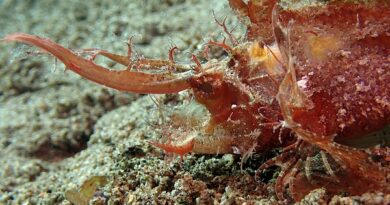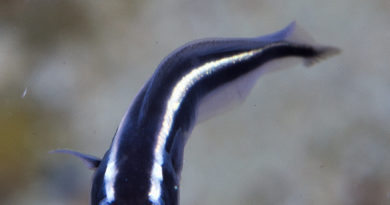Convict not-a-Blenny
One of the most unusual fish on the coral reef is Pholidichthys leucotaenia, sometimes called the convict blenny, sometimes the engineer goby, while it is, in reality, neither a goby nor a blenny, but a member of the family Pholidichthyidae. It’s a fish with a very unusual reproductive behavior. The juveniles seem to be feeding the young!
The juveniles swarm all over the reef, hectically hunting plankton, typically in schools of 100s, about a meter or less above the substrate. The juveniles are common, however the adults, which look like a gigantic goby, are rare. They reside in self-dug tunnels, and only their head emerges every couple of minutes the push out some rubble or sand. The juveniles, when near such a tunnel entrance, swarm in and out of the borrow. I have seen the juveniles many times, but the adults only three times, once in Malapascua, once in Anilao, and once in Sumilon island, all in the Philippines.
There is, to my knowledge, only one published study into the behavior of these unusual fishes, by the well-known marine scientist Eugenie Clark and colleagues (Clark, Eugenie, et al. “Burrow distribution and diel behavior of the coral reef fish Pholidichthys leucotaenia (Pholidichthyidae).” Aqua, International Journal of Ichthyology 12 (2006): 45-82.).
Regarding the feeding behavior, the authors state that ” Clusters of larvae or juveniles hung from the burrow ceiling by mucus secreted from glands on their heads and often were scooped into mouths of adults and then released apparently unharmed.”
The authors also state that the “stomachs of the six adults we collected were basically empty, except for green chyme.” and they speculate that “Juveniles produce mucus, which could provide nutrition for the adult.”. It seems the juveniles regurgitate their food when taken into the mouth of the much larger adult, and this is how the adult feeds.
Fascinating – A Bit More Context
A few years ago I published a paper arguing that a number of boundary conditions of the marine environment have prevented fishes from evolving eusocial species (Stiefel, Klaus M. “Why are there no eusocial fishes?.” Biological Theory 7.3 (2013): 204-210.). Eusocial means that even reproduction is socialized, and that only a select few individuals reproduce, like the queens in ants and bees. No eusocial fishes are known to my knowledge. But is there an exception after all?
One generation (offspring) feeding another (parents) sounds certainly somewhat like an eusocial species! This type of behavior is no proof, but certainly a hint at eusociality. The convict fish needs more science to be done to it.
Photo- and Videography of Convict Fish
During the last years I got a few shots of these unusual fishes, surprisingly few, since they are rather common in some spots. I remember encountering them frequently in Moalboal/Cebu, and just last week I encountered several schools of juveniles in Sumilon/Cebu, and Apo Island. They are not easy to photograph, since they move fast in mid-water.Click on the image below to scroll through my Flickr album with these fish.
This is a video of the adult fish in its burrow, with the juveniles entering and leaving. It’s not a great video in terms of lighting, since I shot it without a video light, with my SLR, before I had really taught myself underwater videography (when I was mainly a still photographer). Still, the behavior is very interesting to watch.
I have some burning questions when it comes to the convict fish:
- Do all juveniles have the potential to become adults, or does a worker caste exist, and only genetically separate fish exist which will become “queens”?
- They have supposedly been bred successfully in aquaria. Is this true, can anyone confirm this? Also, it seems that juveniles have successfully transitioned to become burrowing adults. Again, can any aquarium hobbyist share more detailed information on observing this process? This would contradict the notion that the adults must be fed by juveniles (at least, obligatory, at all times) if that process happened with one juvenile in a tank with no school feeding it.



